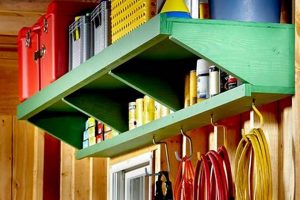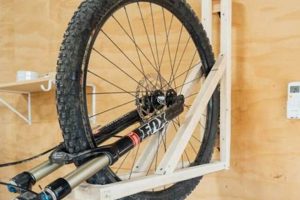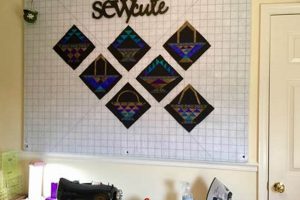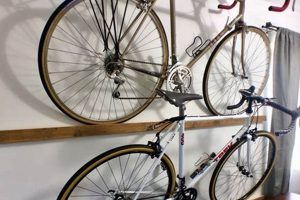A do-it-yourself media center construction refers to the customized assembly of a wall-mounted structure designed to house and integrate electronic entertainment components. This encompasses televisions, speakers, gaming consoles, and associated wiring, often incorporating shelving, storage cabinets, and aesthetic design elements. An example includes a homeowner constructing a recessed area within a wall to flush-mount a large-screen television, flanked by custom-built shelving for media storage and display.
Such constructions offer considerable advantages, including space optimization, enhanced aesthetic appeal, and the potential for cost savings compared to purchasing pre-fabricated entertainment centers. Historically, homeowners relied on furniture pieces to house media equipment. The shift toward integrated wall systems reflects a desire for cleaner lines, better organization, and personalization to match individual interior design preferences and technological requirements.
The subsequent sections will detail crucial planning considerations for this type of project, explore various design styles and material options, provide step-by-step construction guidance, and address essential safety precautions for ensuring a successful and enduring result. Furthermore, considerations for cable management and the integration of smart home technology will be outlined.
Essential Considerations for Media Center Construction
The successful creation of an integrated wall-mounted media system necessitates careful planning and execution. Prioritizing these key aspects will contribute significantly to both the project’s feasibility and its long-term utility.
Tip 1: Structural Assessment: Before commencing any construction, evaluate the wall’s load-bearing capacity. A hollow wall may necessitate reinforcement to support the weight of a large television and shelving. Consult a structural engineer if unsure.
Tip 2: Precise Measurement and Planning: Accurately measure the dimensions of all electronic components and storage items. Develop a detailed plan, including wire management routes, to avoid spatial constraints during installation.
Tip 3: Electrical Considerations: Plan for adequate electrical outlets and surge protection. Consider the future addition of new devices and incorporate spare capacity into the electrical design. Adherence to local electrical codes is paramount.
Tip 4: Ventilation Provision: Electronic devices generate heat. Incorporate ventilation solutions, such as strategically placed vents or cooling fans, to prevent overheating and extend the lifespan of components.
Tip 5: Cable Management Strategies: Implement a comprehensive cable management system. This may include using cable ties, conduits, or wall plates to conceal and organize wiring. This improves aesthetics and prevents accidental disconnections.
Tip 6: Aesthetic Cohesion: Select materials and finishes that complement the existing interior design. Consider the color palette, texture, and overall style to create a visually harmonious integration.
Tip 7: Accessibility for Maintenance: Design the installation to allow easy access for future maintenance and repairs. Avoid permanently enclosing components that may require servicing. Removable panels or access doors can facilitate this.
Adhering to these recommendations minimizes potential issues during construction and ensures a functional, aesthetically pleasing, and safe media center installation. Thorough preparation is key to long-term satisfaction with the finished project.
The following sections will address specific design styles and provide detailed instructions for various construction techniques.
1. Space Optimization
Space optimization, in the context of a do-it-yourself media center construction, denotes the efficient and strategic utilization of available area to maximize both functionality and aesthetic appeal. The effect of proper spatial planning is a reduction in clutter, an improved viewing experience, and an enhanced sense of order within the living environment. Inadequate consideration of spatial constraints can result in a cramped, visually unappealing, and functionally limited installation. For example, failing to account for the depth of a television can lead to the unit protruding excessively from the wall, disrupting the room’s flow and visual balance. Therefore, Space Optimization is a component of paramount importance.
Effective space optimization is achievable through several methods. Wall-mounting televisions and other components frees up floor space typically occupied by traditional media consoles. Recessed shelving and cabinets can be integrated within the wall structure, providing storage without encroaching upon the room’s footprint. Utilizing vertical space by designing tall, narrow storage units further maximizes available area. For instance, a narrow vertical cabinet could house a Blu-ray collection, freeing up valuable shelf space for decorative items or other media components. Proper planning for wire management also contributes to space optimization, as concealed cabling eliminates the visual clutter associated with tangled wires and power cords.
In summary, space optimization within the framework of a media center construction represents a critical design consideration. Its practical significance lies in the transformation of a potentially cluttered and inefficient area into an organized, aesthetically pleasing, and functional entertainment space. Overlooking this component can lead to suboptimal results, while prioritizing it contributes to a more livable and enjoyable environment. It is a key factor that directly impacts the overall success of such a project.
2. Component Integration
Component integration is a critical aspect of media center construction, directly influencing the system’s functionality, aesthetic appeal, and overall user experience. This process involves the seamless incorporation of diverse electronic devices and supporting infrastructure within a unified architectural framework.
- Audio System Integration
The strategic placement and connection of speakers, amplifiers, and receivers significantly impact sound quality and immersion. Integrating these components involves concealed wiring, acoustically optimized speaker placement, and calibration to room characteristics. Failure to properly integrate an audio system can result in distorted sound, unbalanced audio levels, and a diminished listening experience. For instance, in-wall speakers require careful wiring and placement to deliver optimal audio fidelity without compromising aesthetics.
- Video Display Integration
This encompasses the mounting of televisions or projectors, ensuring proper viewing angles, and managing associated video cables. The size and resolution of the display must be appropriate for the viewing distance and room dimensions. Furthermore, cable management is crucial to prevent visual clutter and ensure easy access for maintenance. An improperly integrated video display can result in eye strain, poor image quality, and an unorganized appearance. For example, concealing HDMI cables within the wall requires careful planning and the use of appropriate wall plates.
- Media Storage Integration
Incorporating storage solutions for physical media, such as Blu-rays and DVDs, as well as digital media devices, is essential for organization and accessibility. This may involve custom shelving, cabinets, or integrated storage units. The storage solution should be designed to accommodate the current media collection and allow for future expansion. An inadequate storage solution can lead to clutter, difficulty locating desired media, and a disorganized overall appearance. For example, a built-in cabinet with adjustable shelves can provide flexible storage for various media formats.
- Power and Connectivity Infrastructure
Providing adequate power outlets, surge protection, and network connectivity is vital for reliable operation of all electronic components. This involves careful planning of electrical circuits, the use of high-quality cables, and the implementation of a robust network infrastructure. Insufficient power and connectivity can result in equipment malfunctions, data loss, and a compromised user experience. For instance, installing a dedicated circuit for the entertainment center can prevent overloading the existing electrical system.
The degree of component integration within a media center construction fundamentally defines its utility and aesthetic value. A well-integrated system provides a seamless and immersive entertainment experience, while a poorly integrated system can result in frustration and detract from the overall aesthetic of the living space. Proper planning and execution are essential to achieve optimal component integration, ensuring that all elements work harmoniously together to deliver a superior entertainment experience.
3. Aesthetic Harmony
Aesthetic harmony, within the context of a do-it-yourself media center construction, refers to the cohesive integration of the structure and its components with the existing interior design of the room. This integration goes beyond mere functionality, aiming to create a visually pleasing and balanced environment that enhances the overall viewing and living experience. Achieving aesthetic harmony requires careful consideration of various elements, including color palettes, material choices, lighting, and spatial arrangement.
- Color Palette Coordination
The selection of colors for the media center should complement the existing wall color, furniture, and dcor. Contrasting colors can create visual interest, but should be used sparingly to avoid a jarring effect. Neutral tones often provide a safe and versatile backdrop, allowing the electronic components to stand out without clashing with the room’s overall aesthetic. For instance, a media center constructed from dark wood might harmonize well with a room featuring earth tones and natural materials.
- Material Consistency
The materials used in the construction of the media center should be consistent with the existing materials in the room. If the room features hardwood floors, incorporating wood elements into the media center can create a sense of continuity. Similarly, if the room has a modern aesthetic with clean lines and metallic accents, using materials such as brushed aluminum or stainless steel can enhance the overall harmony. A mismatch of materials can create a disjointed and visually unappealing effect.
- Lighting Integration
Proper lighting can enhance the aesthetic appeal of a media center and improve the viewing experience. Incorporating dimmable lights can create a more immersive viewing environment, while accent lighting can highlight specific features of the media center. The placement of lights should be carefully considered to avoid glare on the television screen. For example, installing LED strip lights behind the television can create a subtle ambient glow that reduces eye strain and adds visual interest.
- Spatial Arrangement and Proportion
The size and proportion of the media center should be appropriate for the size of the room. A large, bulky media center can overwhelm a small room, while a small, understated media center may get lost in a larger space. The arrangement of the components within the media center should be balanced and symmetrical. A well-proportioned and balanced arrangement creates a sense of visual harmony and order.
The pursuit of aesthetic harmony in media center construction contributes to the creation of a more enjoyable and visually pleasing living space. A well-designed media center that integrates seamlessly with the existing interior design can enhance the overall value and appeal of the home. Therefore, it is a key consideration in the planning and execution of a do-it-yourself project of this nature.
4. Cable Management
Effective cable management is an indispensable element of any do-it-yourself entertainment wall project. It directly impacts the aesthetic appeal, functionality, and safety of the installation. Neglecting cable management can result in a visually cluttered and potentially hazardous environment, while a well-executed system enhances the overall user experience and facilitates maintenance.
- Aesthetic Enhancement
Visible and tangled cables detract significantly from the visual appeal of an entertainment wall. Implementing cable management techniques, such as concealing wires within walls, using cable conduits, or employing cable ties, results in a cleaner and more organized appearance. An example includes routing HDMI cables through a wall-mounted conduit to connect a television to a receiver, thereby eliminating dangling wires and improving the overall aesthetic.
- Improved Functionality
Properly managed cables minimize the risk of accidental disconnections and ensure that all components function correctly. Clearly labeled cables simplify troubleshooting and make it easier to identify and resolve any connection issues. For example, labeling each cable with its corresponding device allows for quick identification during maintenance or reconfiguration, preventing accidental disconnection of the wrong component.
- Enhanced Safety
Loose and exposed cables pose a tripping hazard and can increase the risk of electrical shock. Cable management systems secure wires and keep them out of harm’s way, creating a safer environment for users. Utilizing surge protectors and cable ties further reduces the risk of electrical hazards. Securing power cords and signal cables away from high-traffic areas minimizes the likelihood of accidental damage or injury.
- Simplified Maintenance
Well-organized cables facilitate access to components for maintenance and repairs. Clear labeling and organized routing enable technicians to quickly identify and address any issues without having to untangle a mess of wires. For instance, using removable panels or access doors behind the entertainment wall provides easy access to cables and connections for servicing or upgrades.
In summary, the successful integration of cable management strategies is crucial for the long-term success of any do-it-yourself entertainment wall project. By prioritizing aesthetics, functionality, safety, and maintenance, homeowners can create a visually appealing, user-friendly, and safe entertainment space.
5. Structural Integrity
Structural integrity forms a foundational element in the successful execution of a do-it-yourself entertainment wall project. It dictates the load-bearing capacity, stability, and long-term durability of the installation. A compromised structure not only poses a significant safety hazard but can also lead to costly repairs and the potential loss of expensive electronic equipment. Therefore, meticulous attention to structural considerations is paramount.
- Wall Assessment and Reinforcement
Prior to any construction, a thorough assessment of the existing wall structure is mandatory. This involves determining the wall’s composition (e.g., drywall, concrete, wood studs) and its load-bearing capacity. Hollow walls, for instance, may require reinforcement through the addition of studs or the installation of a backing board to adequately support the weight of televisions, shelving, and associated components. Ignoring this step can result in wall damage or, in extreme cases, structural failure.
- Weight Distribution Planning
The distribution of weight across the entertainment wall is a critical design consideration. Heavy components, such as large-screen televisions, should be strategically positioned and securely mounted to load-bearing members within the wall. Shelving should be designed to evenly distribute the weight of media and decorative items. Uneven weight distribution can create stress points within the structure, leading to instability and potential collapse.
- Mounting Hardware Selection
The selection of appropriate mounting hardware is essential for ensuring the structural integrity of the entertainment wall. Anchors, screws, and brackets must be rated to support the weight of the components they are intended to hold. Using inferior or inadequate mounting hardware can compromise the stability of the installation and create a safety hazard. For example, using drywall anchors to support a heavy television can lead to the anchors pulling out of the wall over time.
- Material Selection for Framework
The materials used to construct the entertainment wall framework directly impact its structural integrity. Wood, metal, and composite materials each offer varying degrees of strength and durability. The selection of materials should be based on the anticipated load and the desired aesthetic. For example, using solid wood for shelving and framing provides greater strength and stability compared to using particleboard or MDF.
These facets of structural integrity are interwoven and contribute collectively to the safety and longevity of the entertainment wall. Proper assessment, planning, and execution in these areas are indispensable. It demonstrates understanding how these inter dependencies contribute to a sustainable and well-performing solution.
6. Future-Proofing
Future-proofing, in the context of a do-it-yourself entertainment wall, denotes the proactive planning and design considerations undertaken to ensure the installation remains adaptable, functional, and aesthetically relevant in the face of evolving technological standards and changing entertainment needs. Neglecting this aspect can lead to premature obsolescence, necessitating costly renovations or complete replacements as new technologies emerge.
- Conduit and Wiring Capacity
The inclusion of ample conduit space and wiring capacity within the entertainment wall is essential for accommodating future upgrades and expansions. Running additional conduit during the initial construction phase allows for the seamless integration of new cables and devices without requiring extensive demolition or rewiring. For instance, installing spare Cat6 or fiber optic cables can facilitate the adoption of higher bandwidth technologies, such as 8K video or advanced audio formats, without significant disruption.
- Modular Design and Adaptability
Employing a modular design approach allows for the easy reconfiguration and expansion of the entertainment wall as needs evolve. This involves using adjustable shelving, removable panels, and flexible mounting systems that can accommodate different component sizes and configurations. For example, utilizing a rail-based shelving system enables the repositioning of shelves to accommodate larger or smaller devices, or the addition of new storage modules as the media collection expands.
- Power and Connectivity Redundancy
Providing redundant power outlets and network connectivity points within the entertainment wall ensures that new devices can be easily integrated without overloading existing circuits or requiring additional wiring. This includes incorporating surge protectors and uninterruptible power supplies (UPS) to safeguard electronic components from power fluctuations. For instance, including multiple Ethernet ports allows for the simultaneous connection of various streaming devices, gaming consoles, and smart home hubs, ensuring reliable network access for all components.
- Anticipating Technological Advancements
Staying informed about emerging technological trends and anticipating future entertainment needs is crucial for effective future-proofing. This may involve researching new display technologies, audio formats, and connectivity standards, and incorporating design elements that can accommodate these advancements. For example, designing the entertainment wall to accommodate larger television screens allows for future upgrades without requiring significant structural modifications.
The integration of these future-proofing considerations into the do-it-yourself entertainment wall project ensures that the installation remains a functional and aesthetically pleasing centerpiece of the home entertainment system for years to come. By anticipating future needs and incorporating adaptable design elements, homeowners can avoid premature obsolescence and maximize the long-term value of their investment. Thoughtful planning in these areas reflects an understanding of future technology trends to enable a sustainable user experience.
Frequently Asked Questions
This section addresses common inquiries and concerns pertaining to the design, construction, and implementation of do-it-yourself media centers, providing concise and informative responses to aid in project planning and execution.
Question 1: What factors determine the optimal television size for a entertainment wall project?
The appropriate television size is primarily dictated by the viewing distance. A general guideline suggests that the viewing distance, in inches, should be approximately 1.5 to 2.5 times the diagonal screen size. Room dimensions and viewing preferences also influence this determination. Smaller rooms benefit from smaller screens to prevent eye strain, while larger rooms can accommodate larger displays for a more immersive viewing experience.
Question 2: What are the recommended safety precautions during the electrical wiring phase of a entertainment wall construction?
Safety is paramount when dealing with electrical wiring. Disconnect power to the circuit breaker before commencing any electrical work. Utilize appropriate safety equipment, including insulated gloves and safety glasses. Adhere strictly to local electrical codes and regulations. If unfamiliar with electrical wiring, consult a qualified electrician to ensure safety and compliance.
Question 3: What materials are most suitable for constructing the framework of a entertainment wall designed to support heavy components?
Solid wood, such as oak or maple, provides excellent strength and stability for supporting heavy components. Metal framing, particularly steel, also offers high load-bearing capacity and durability. Particleboard and MDF are less suitable for supporting heavy loads and may require additional reinforcement.
Question 4: How can cable management be effectively implemented within an entertainment wall to minimize visual clutter?
Effective cable management involves concealing wires within walls using conduits or cable raceways. Cable ties, Velcro straps, and labeled cables aid in organization and identification. Wall plates with brush inserts provide a clean and professional finish. Strategic planning for wire routing during the design phase is crucial for seamless integration.
Question 5: What are the key considerations for incorporating adequate ventilation into a entertainment wall to prevent overheating of electronic components?
Proper ventilation is essential to prevent overheating and extend the lifespan of electronic components. Incorporate ventilation slots or grills into the design to allow for airflow. Consider using cooling fans to actively dissipate heat. Ensure that components are not tightly enclosed and have adequate space for air circulation.
Question 6: How can a entertainment wall be designed to accommodate future technological upgrades and changing entertainment needs?
Future-proofing involves incorporating spare conduit and wiring for future connections. Modular shelving and adjustable mounting systems allow for flexible configuration. Providing ample power outlets and network connectivity points ensures compatibility with new devices. Staying informed about emerging technologies enables proactive planning for future upgrades.
In summary, addressing these frequently asked questions promotes informed decision-making and contributes to the successful design and construction of a functional, aesthetically pleasing, and safe do-it-yourself entertainment wall.
The following section will explore specific design styles and provide practical construction tips for various project scenarios.
Conclusion
The preceding sections have detailed the multifaceted considerations involved in the creation of a custom media center. From initial structural assessments and meticulous planning to aesthetic integration and forward-looking design, the construction of a diy entertainment wall demands a comprehensive approach. The successful execution of such a project necessitates a thorough understanding of spatial dynamics, component integration, and safety protocols.
The information presented serves as a foundation for informed decision-making. Further research and consultation with qualified professionals may be warranted based on specific project requirements and individual skill levels. The creation of a bespoke entertainment space requires dedication and precision but offers the potential for a highly personalized and functional addition to the home. The time investment and commitment to safety yield a system uniquely tailored to the owner’s needs and preferences.







